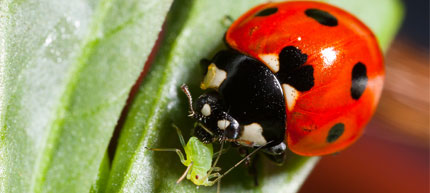Research by the University of Liverpool has found that the redder ladybirds more poisonous.
The study by the Universities of Liverpool and Exeter reveals that variation in colour is directly linked to diet in early life, with better-fed ladybirds being more visible and more deadly.
Ecologists have long assumed that there are no individual differences between the warning signals of animals of the same species. More recently, however, scientists have identified a variation between individuals’ warning signals, but have not known if these differences were meaningful and linked to levels of toxicity.
In this study, the researchers reared seven-spot ladybirds on either a low or high quality diet. They measured several effects of varying diet in the maturing ladybirds: body colouration which acts as a warning signal, levels of toxic defensive chemicals, and the relationship between signals and defences.
Ladybirds that were fed a high quality diet had greater pigmentation – resulting in redder wings – than less well-fed ladybirds. They also had higher levels of precoccinelline, one of the defensive chemicals which make them toxic to birds. The study therefore suggests that better-fed ladybirds can afford to invest more into producing both warning signals and toxic chemicals, and are therefore less likely to be eaten by a predator.
Dr Mike Speed, of the University’s Institute of Integrative Biology, said: “There seems to be an ‘arms race’ between prey: those without good access to food are less toxic, so they try to copy the brighter, more expensive signals of the more toxic animals that have better access to food. However, the well fed animals appear to win the battle as the signals they make are too bright and expensive for the other animals to copy.”
Dr Jon Blount, of the University of Exeter, added: “Warning signals tell us far more about the strength of an individual’s defences than has previously been thought. Producing warning signals and chemical defences is costly, so when individuals lack access to an abundant supply of food they produce relatively weak chemical defences. This is revealed to predators through relatively inconspicuous signals. However, when resources are more abundant, ladybirds invest in stronger chemical defences and more conspicuous signals.”
Although the variation between individual ladybirds’ colouration appears quite subtle to humans, it is easily identified by birds. In this study, the research team measured the pigmentation of ladybirds biochemically, and ascertained the relationship between pigment levels and conspicuousness to a typical avian predator, the starling.
Because so little is known about the day-to-day movements of ladybirds, the research team does not know how paler ladybirds protect themselves against detection by predators. One possibility is that they hide away more than brighter ladybirds
This study was carried out by the Universities of Liverpool, Exeter, Cambridge and Keele in the UK, Deakin (Australia) and Groningen (Netherlands). It was funded by the Natural Environment Research Council and the Royal Society.
The research is published in the journal Functional Ecology.
